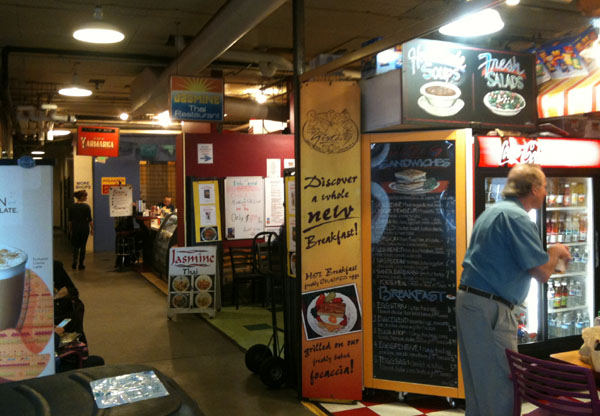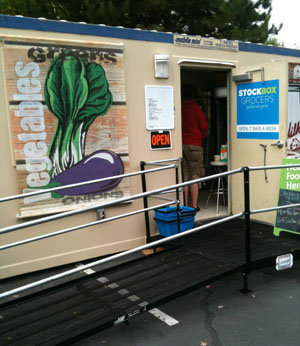S400: Micro-Retail
The suburban binge of the last fifty years has left U.S. cities with too little neighborhood retail, too few locally-owned shops, an extreme dearth of sidewalk enterprise, and unemployment. Micro-retail, in all its many forms, is a solution.

< Pike Place Market >
Micro-retail is not a new solution, but a rediscovery of what has worked for centuries. The oldest parts of Seattle have remnants of traditional retail; the newer parts of the city have big-box centers and miles of retail-light neighborhoods. Retail has been clustered in ways that cater to the automobile, not the person, and cater to large retail chains, not neighborhood residents. Retail is taken out of the hands of local entrepreneurs, and into the hands of large corporations and their banks.

< 3rd Ave in downtown Seattle >
What is micro-retail? Retail at a smaller scale:
- Narrow storefront shops, 20 feet wide or less
- Food trucks
- Sidewalk carts and kiosks
- Newsstands
- Co-located businesses (operating in the same space at different hours)
- Live/work lofts

< 2nd Ave in downtown Seattle >
Narrow storefronts are essential to thriving pedestrian streets. The standard U.S. retail bay is 30 feet wide, and a great many stores around here take up way more street space (hello Safeway). With narrow shops the pedestrian is presented with a new visual experience every few seconds. Where there are dead spaces, such as parking lots or vacant land, food trucks and retail carts lined up against the sidewalk create value and enliven the space. With carts and kiosks and newsstands, even the sidewalks can be filled with business. In addition to enlivening the urban experience, each of these micro-retail concepts reduces the cost and risk of starting a new business. In an era when banks have curtailed capital for small businesses, retail startups need low costs.

Â
 In South Lake Union there is a full-service sushi and teriyaki restaurant operating in a building about 12 feet wide. Why is more space needed? There is a lady in White Center who often sells grilled satay along the sidewalk. I’ve bought freshly fried banana in a parking lot in Little Saigon. You can now buy groceries from a remodeled trailer in an apartment complex parking lot in West Seattle. The Pike Place Market is the original and largest local example of micro-retail. Hundreds of farmer’s stalls and tiny shops are clustered in a few blocks: seafood, mini-doughnuts, Reuben sandwiches, fresh-squeezed juices. Much of the market’s attraction to tourists is simply the clustering of diverse local unique businesses into a dense, pedestrian-scaled place.
In South Lake Union there is a full-service sushi and teriyaki restaurant operating in a building about 12 feet wide. Why is more space needed? There is a lady in White Center who often sells grilled satay along the sidewalk. I’ve bought freshly fried banana in a parking lot in Little Saigon. You can now buy groceries from a remodeled trailer in an apartment complex parking lot in West Seattle. The Pike Place Market is the original and largest local example of micro-retail. Hundreds of farmer’s stalls and tiny shops are clustered in a few blocks: seafood, mini-doughnuts, Reuben sandwiches, fresh-squeezed juices. Much of the market’s attraction to tourists is simply the clustering of diverse local unique businesses into a dense, pedestrian-scaled place.
Micro-retail allows people to put themselves to work as entrepreneurs, keeps dollars circulating in the local economy, creates viable neighborhoods and reduces auto dependence. Micro-retail is a solution for the city and for the economy. Let’s have more!
>>>
Chad Newton is an Environmental Engineer and Seattle resident. All photos by the author.

